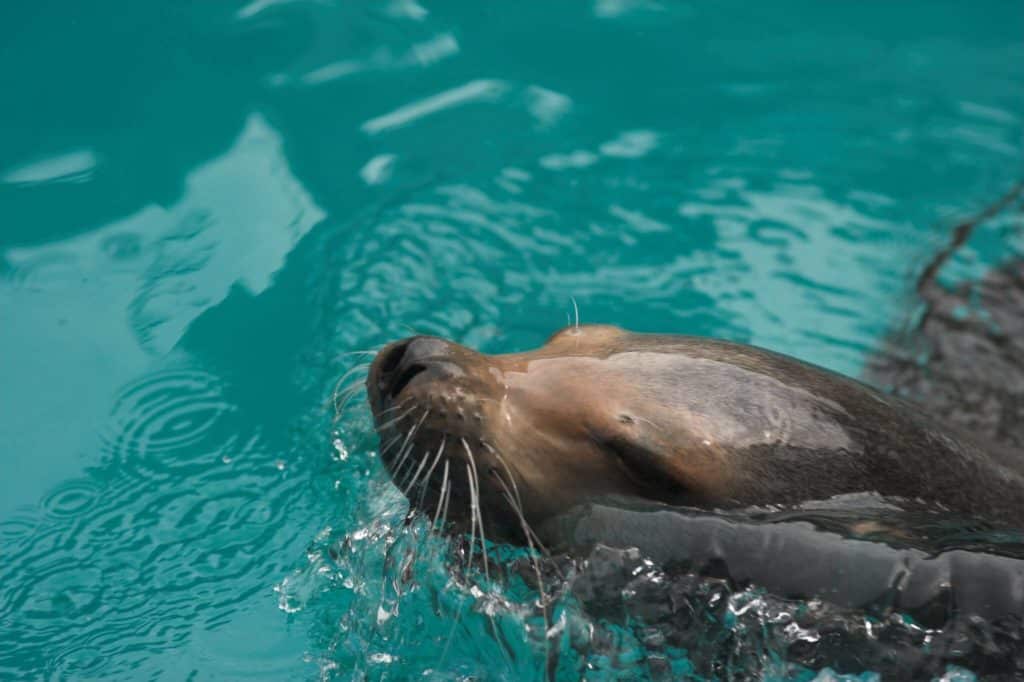Sea lions are a crucial part of many marine ecosystems and can be found in coastal waters all over the world.
They feed mainly on krill, fish, and squid and are part of the ‘pinniped’ family alongside seals and walruses.
In this post, we’re going to take a closer look at the sea lions population and answer are sea lions endangered?
No, as a whole, many species of sea lions are not endangered. However, some species such as the stellar sea lion are protected and are classified as endangered.
Are Sea Lions Currently Endangered?
Sea lions currently have an extinction status as ‘Not Endangered’ – meaning that there is no current threat to the general population of the species as a whole.
The eastern population of Steller sea lions which ranges from Cape Suckling in Alaska to the Channel Islands off the coast of Southern California is currently listed as ‘threatened’ on the Endangered Species List.
Steller sea lions are the largest of the eared seals and were first added to the Endangered Species List back in 1990 due to steep declines in their populations.
The good news is that the Stellar sea lion population is making an incredible recovery.
With only around 34,000 eastern Stellar sea lions in 1997, estimates from 2010 put the population at about 70,000.
Thanks to conservation efforts scientists believe that the population has increased by around 4.3% per year since the late 1970s, and are now discussing removing the species from the Endangered Species List.
Do Sea Lions Have Threats?
As with many marine animals, sea lions do face threats that put their population at risk.
For the longest time, humans thought these sea lions were stealing their catch and would shoot them, drastically reducing their numbers.
In many areas, there are laws that protect sea lions from being hunted, harmed, or killed, but this doesn’t stop people from doing exactly that in some places.
In some countries such as Japan, there are laws to protect sea lions, but they simply are not enforced, and therefore shooting sea lions still happens there.
Adult sea lions also tend to suffer from a range of health issues, including cancer, epilepsy, and even pneumonia which is a threat to their population.
Besides biological threats, one cause of sea lion mortality is that pups are often killed whilst they are still young.
Sea lions tend to live in colonies that are tightly packed to stay protected against predators, however, adult sea lions accidentally sit on and squash pups, which is a real threat to the future population.
Many species of sea lions are very aggressive towards each other, mother cows will even toss, shake and sometimes kill other calves that are not their own.
Male sea lions even sneak up and steal baby sea lions, using them for herding practice and harem keeping.
How Many Sea Lions Are Left In The World?
It’s hard to estimate the number of sea lions throughout the world, as numbers are always changing.
The Stellar sea lion population in particular has decreased quite a lot over the past few decades. In 1961, there was an estimated population of between 240,000 to 300,000 and just 30 years later, in 1991 that number dropped to only 40,000.
Only recently at Marmot Island, there were 10,000 sea lions crowding the seven rookeries and each season around 5,000 pups were born.
Now many of those same beaches are empty, and less than 3,000 sea lions were counted during a recent summer breeding season there.
It’s safe to say that many species of sea lions are at risk, and due to the number of threats, they are under it’s difficult to know how quickly their numbers will bounce back, if at all.
The good news is that conservation efforts are being put in place all over the world in order to protect and help sea lion numbers recover.
What Would Happen If Sea Lions Went Extinct?
Sea lions are a vital part of marine ecosystems in many oceans all around the world, they are predators that kill off weak fish in order for the strongest of their prey to survive and reproduce.
Without sea lions, lame fish would survive and diseases would be passed down and more lame fish would be born, resulting in fisheries catching lame fish.
Sea lions are predators that play a structural role by influencing the physical complexity of their environment, or they may synthesize the marine environment and serve as indicators of ecosystem change.
The excrement of sea lions also acts as a fertilizer for underwater coral and plants, providing them with the nutrients they need to grow and thrive.
Final Thoughts
So, are sea lions endangered? Largely no, but there are some species that are endangered and near extinction in recent years.
Sea lions face a number of threats that put their species at risk. Unlike many animals that are having their environments taken away, many sea lion threats are from their own species and behaviors.
Conservation efforts have had a real push in recent years, but due to sea lions only having roughly one pup every year, rebound rates are slow.
Hopefully, this post has been helpful and you’ve learned something new today about sea lions and why some species are endangered.
Thanks for taking the time to read this post and feel free to share it with others that may find it of value.

Hi, I’m George – the founder of MarinePatch. I created this blog as marine wildlife has been my passion for many years. I’ve spent over a decade in the marine wildlife industry and spent years out in the field conducting research. In today’s modern world, an online blog is the best place for me to share my findings and reach as many people as possible to help educate and inspire others. Enjoy your time here and you’re welcome back anytime!

